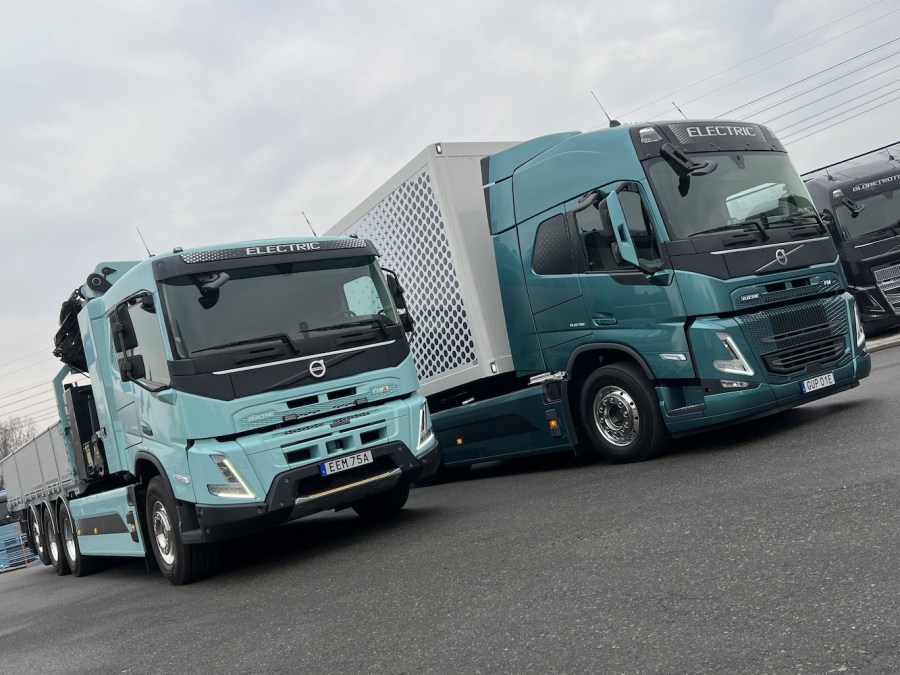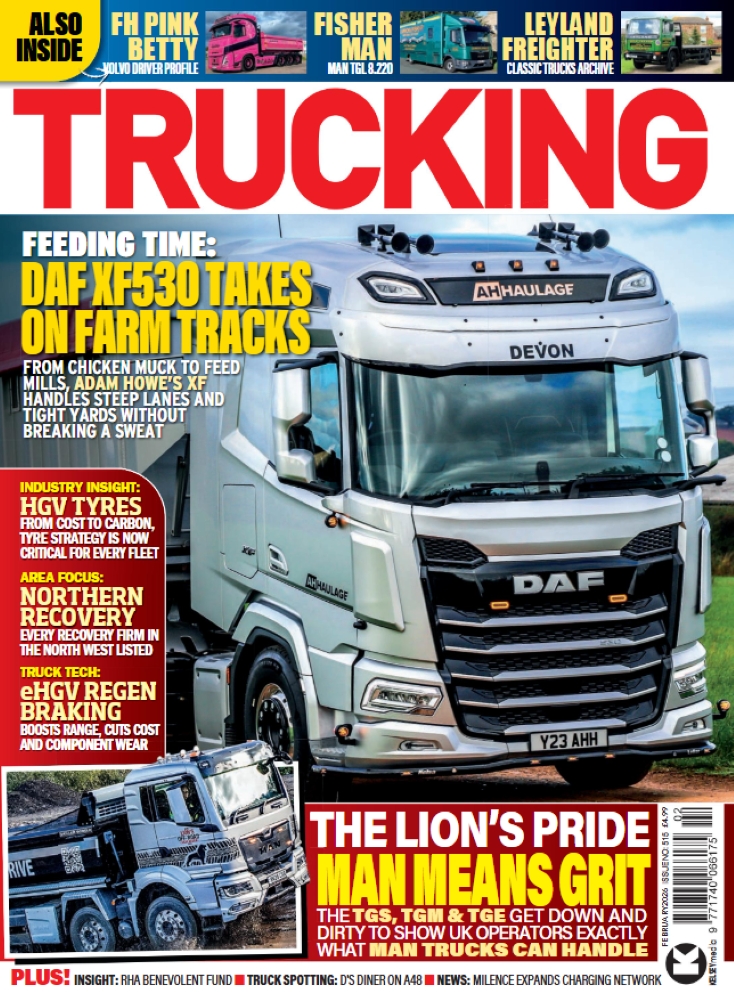As Volvo unveils battery-powered versions of its heavy trucks, we head to Sweden to try out prototype versions of an FM Electric tractor unit and FMX Electric rigid.
The move towards diesel alternatives for commercial vehicles is gaining speed, with Volvo targeting a reduction in emissions from its trucks and buses by 40 per cent per vehicle km by 2030.
The overall goal is a complete step away from fossil fuels by 2040. In fact, all the major truck manufacturers are racing to perfect fossil-free drivelines. The clock is ticking, the change is coming, and preparations are being made in earnest.
The Swedish manufacturer recently announced FH, FM and FMX heavy trucks are next to receive a battery-electric drivetrain, with order books now open for those keen to try their hand at ditching diesel for certain operations. This means Volvo’s entire range is now available to order as BEVs, with the new trio joining the already-launched electric versions of FL and FE in Europe, plus the VNR Electric for the North American market.
Production of FH, FM and FMX Electrics will initially start with tractor units in the second half of 2022, followed by rigids in the beginning of 2023.
The three new heavies are aimed at regional distribution and construction markets and offer GCWs of up to 44 tonnes. They can be spec’d with two chassis height options, with wheelbases ranging from 3800 to 6700 mm.
As a legacy manufacturer, Volvo’s route to electrification involves tweaking some of its existing hardware (transmission, for example) to work with new electric motors. Its solution involves a number of electric motors attached directly to a modified gearbox, which together form what Volvo is calling the Electric Drive Unit (EDU).
The lower-weight FL Electric uses one motor, FE Electric uses two, while FH, FM and FMX Electric use three electric motors directly attached to an I-Shift transmission. This affords the heavy models a total power output of 490 kW (666 bhp) and a whopping 28,000 Nm of torque.
Battery choices
Batteries and service boxes are fitted along the side of the chassis. The battery assembly is built by Volvo and currently uses an array of Li-Ion Samsung cells. Each assembly offers 90 kWh of power and weighs around 500 kg – so buyers need to be careful to spec the right amount of power to meet their needs, as payload and operating range are directly affected.
We were told that in Sweden, operators running electric trucks are permitted to carry additional payload to mitigate battery weight. Sadly, there’s currently no such consideration for HGVs in the UK (although there is for electric vans).
Operators can choose to load the three electric heavies with between three and six battery packs, with a maximum 540 kWh nominal capacity. As an illustration, Volvo reckons an FH Electric 4×2 tractor unit with six batteries running at 30 tonnes GCW will have a range of up to 300 km (186 miles) on a full charge.
There are three power take-off (PTO) options: electric (40 kW), electro-mechanical (70 kW), and finally gearbox-mounted (150 kW).
Trucking recently visited the manufacturer’s HQ in Gothenberg, Sweden to take a closer look at the new trucks – and take some prototypes out on the road to see what they are like to drive. Sadly, an FH Electric wasn’t available, though we did spot a couple of examples lurking outside Volvo’s battery research centre.
On the road: FM Electric
Our first test vehicle was an FM Electric tractor unit. Climbing into the familiar and comfortable FM cab, we were surprised to find the truck was already switched on and ready to go. The lack of engine noise is the first thing that hits you with an electric vehicle; but sure enough, a touch of the pedal and we were off.
Volvo told us legislation requires it to add synthetic noise to its series-produced electric vehicles so they can be heard by other road users, but these prototype models were not fitted with such a system.
Loaded to 33 tonnes, the truck aims to start in the highest possible gear (usually seventh) to save energy through reduced shifting. However, running through an adapted 12-speed I-Shift, lower gears are available if necessary – for example, when starting off on a steep incline or in situations that require additional torque and control.
Pulling away, we found the FM Electric gave that linear, smooth and powerful acceleration we’ve come to expect with EVs. The motors deliver loads of low-down torque and it makes for a very positive drive.
Once out of Volvo’s test complex and onto the open road, the I-Shift ’box switched straight up to 9th and then 12th as soon as possible. The changes are as noticeable as a normal shift on a conventional diesel driveline; but with far fewer shifts overall, the drive felt super-smooth.
Once we’d acclimatised to the torquey engine, we settled in for a relaxed tour of the immediate Swedish countryside. We didn’t encounter many hills so couldn’t get much of a feel of how the truck performs under heavy load, but performance at junctions, roundabouts etc was very sprightly. After half an hour, we pulled into a fuel station to swap over for our next ride.
On the road: FMX Electric
Next up was an FMX Electric rigid. Repeating the same route in reverse, this time we were focused on driving the BEV ‘properly’ (ie, not like a diesel) and this mostly involves a change in braking behaviour.
Though we’re told the series-produced electric trucks will have a tweaked engine brake, our prototype FMX was using a conventional-style three-stage version with an automated option.
We were advised the strategy the driver needs to employ is almost backwards to that used on a conventional driveline. Instead of leaving the engine brake off and only flicking the stalk when you need to slow down, the most energy-efficient way to use it on an electric truck is to leave it in stage three for the duration of the drive.
This way, the driver knows that whenever they lift off the power, the truck slows using the engine brake and regenerates the maximum amount of energy back into the cells. Effectively this means you can drive using just one pedal for much of the time, with service brakes called on only rarely.
It’s likely Volvo will automate all this when it comes to series production by tweaking the engine brake controls to ensure this happens in its Automated setting. But for now, we’re told this is the most consistent way to get power back into the cells while on the road.
Driving behaviour is one of the biggest factors that influences power drain when operating BEVs. Others are weather conditions, tyres, topography, and load. According to Volvo, drivers have the potential to reduce energy use by up to 20 per cent if they use the vehicle correctly – so proper driver training and coaching is going to be very important.
Verdict
Though the technology is still in relative infancy, we continue to be impressed by the drivability of electric trucks. Though we didn’t get to try the FH Electric, Volvo’s FM and FMX versions give a genuinely positive driving experience. The vehicles are still prototypes, but we think they succeed as a proof of concept.
The wrinkles, of course, are range and payload. Cell technology is getting better and the next generation of batteries will offer higher energy densities, which means hauliers will need to spec fewer battery packs to meet their required operating range – therefore reducing the truck’s payload penalty.
The concept of regular charging needs to be fully understood by the operator and built into the vehicle’s daily working schedule. Charging via breaks will become particularly important – and this will require the UK’s network of charging points to be up to the job.
Until then, BEV operators will need to carefully plan work cycles and spec their trucks correctly for return-to-base activities. Thankfully, Volvo – and indeed the other major manufacturers – offer detailed consultations on this ahead of purchase to ensure demands can be adequately met.
But make no mistake – BEVs are here to stay. And soon enough (in just eight years’ time, according to Volvo), production will be split 50/50 between electric trucks (including BEV and hydrogen fuel cell) and those based on internal combustion engines.
The question is: at what point will your business get on board?
Likes:
+ Incredibly quiet
+ Excellent drivability
+ Immediate torque
Dislikes:
– Charging requirements need careful consideration
– Only suits certain applications at present
Test specifications
- Volvo FM Electric 4×2 tractor unit
- Chassis: Medium height, 3900 mm wheelbase
- Test GCW: 33 tonnes
- Front axle: 8.5-tonne capacity, air suspension
- Rear axle: 12-tonne capacity, single reduction, 3.08 ratio, air suspension
- Engine: 3x electric motors
- Max power: 490 kW (666 bhp)
- Max torque: 2800 Nm
- Gearbox: 12-speed I-Shift
- Batteries: 6x battery packs, 540 kWh
- Additional equipment: High Sleeper Cab, Volvo Dynamic Steering
- Volvo FMX Electric 8×4 rigid
- Chassis: Medium height, 4600 mm wheelbase
- Test GCW: 32 tonne
- Front axle: 10-tonne capacity single, air suspension
- Rear axle: 27-tonne capacity tridem, 3.09 ratio, air suspension
- Engine: 3x electric motors
- Max power: 490 kW (666 bhp)
- Max torque: 2800 Nm
- Gearbox: 12-speed I-Shift
- Batteries: 6x battery packs, 540 kWh
- Additional equipment: Sleeper Cab, Volvo Dynamic Steering, Palfinger crane with flatbed






